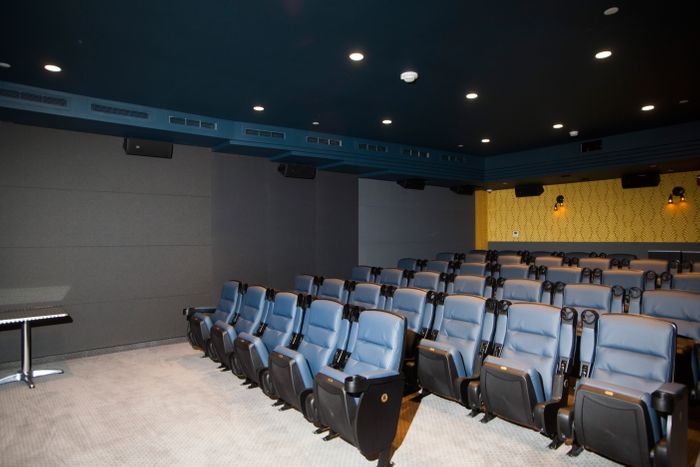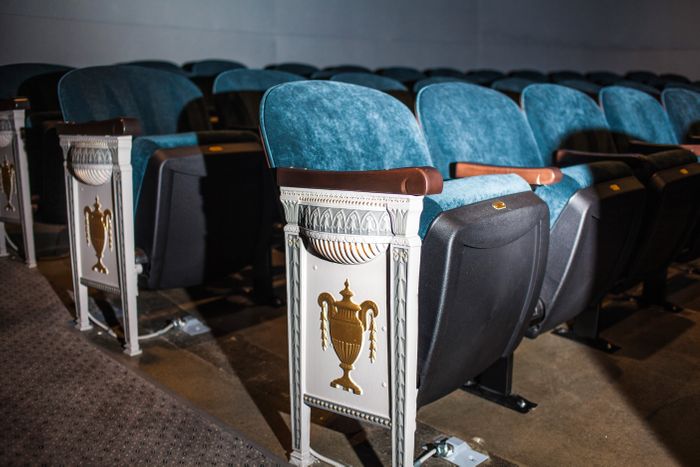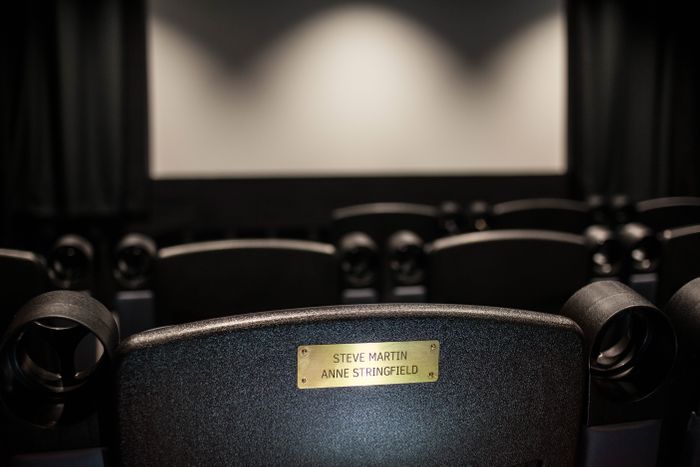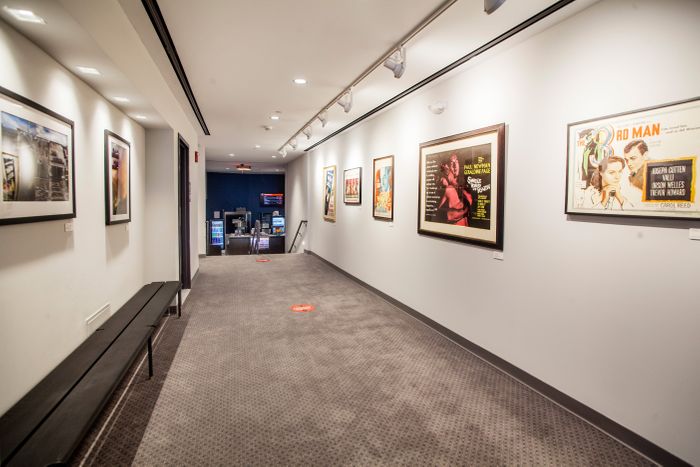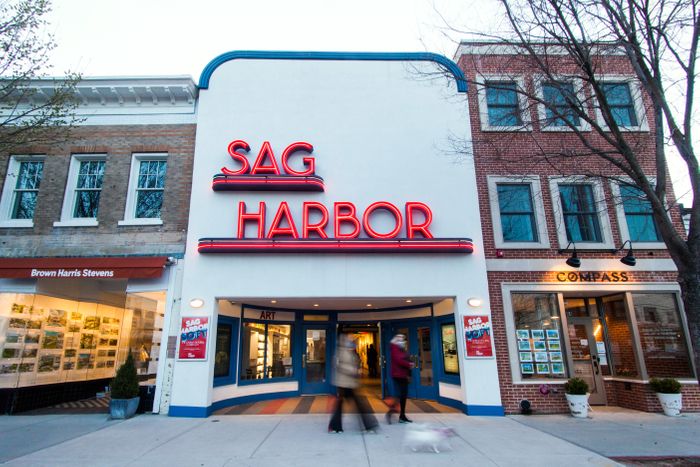
From the sidewalk, the Sag Harbor Cinema, with its red neon sign, curved stucco exterior, glass-tiled portico, and blue recessed doors, looks as if it has been untouched since Jean Harlow was the main draw. But much of what you see at 90 Main Street today is brand-new. In 2016, the theater was nearly destroyed by a fire that is believed to have started in a nearby building. The new façade is a meticulous reproduction, and though the neon sign is original — it was saved from the blaze by the local fire department — it had to be reconstructed and restored. Much of the interior had to be rebuilt as well. It’s the work of the Sag Harbor Partnership, a local nonprofit community organization run largely by volunteers, which launched a massive rebuilding effort, raising money from donations and grants. Artists Eric Fischl and April Gornik were among those involved in launching the project; Fischl gave an early donation and Gornik has chaired the campaign. The redesign — which was led by architect Allen Kopelson of NK Architects — took several years and was delayed by the pandemic; this month, the century-old theater is reopening in stages, and this is the first extensive look inside.
For locals, its return is an exciting and emotional event. Growing up nearby, I went to the theater often. It was where my friends and I would meet on weekends to watch old horror movies, and it was where I went every December with my parents to see It’s a Wonderful Life. It was the site of many summer matinees and awkward high-school dates. The theater had a damp, dusty smell, creaky red seats, and perpetually stale popcorn. Everyone in town, it seems, has a story about being the only person in the house — or one of a handful — at a winter-night screening. In recent decades, as Sag Harbor adapted to a modern (and exceedingly wealthy) clientele, the theater remained comfortingly shabby, a lingering piece of the old village.
Built in the 1890s, the building originally housed a vaudeville and burlesque theater. Around the turn of the century, a projector and screen were brought in so silent films — Charlie Chaplin flicks and the like, on celluloid — could be screened on Saturday nights. As filmmaking technology developed, so did the theater, and in the late 1920s, speakers were installed and the auditorium was expanded to show talkies. In 1936, the architect John Eberson — known for dozens of “atmospheric” theaters around the country — remodeled the cinema, establishing its distinctive Art Deco aesthetic, putting in a curved marquee, red plush carpeting, and a brass ticket counter. In 1978, Gerald Mallow, a local cinephile, bought the theater and transformed it into an art house, and it remained his for 38 years. After the fire, Mallow — who at that time was nearing 80 — sold the charred building to the Partnership, whose restoration aimed to eliminate the theater’s underlying ricketiness while retaining the small-town feel.
Multiple Screens
The biggest change to the theater involved reconfiguring the single 500-seat auditorium into two smaller rooms: one with 227 seats and another with 98, with a concession stand in between. “A 500-seat theater is sort of antiquated,” says the executive director, Jamie Hook. “We went with a design that would offer more flexibility.” The new structure also includes a 40-seat screening room upstairs (with “big, fat fancy seats”) for special events.
Historical Details
Although the building’s façade and lobby were destroyed, the main auditorium was largely spared, and the designers, says Hook, threw themselves into painstaking reconstructive work. The light fixtures and the illuminated exit signs, for instance, are original, and the cast-iron seat ends were stripped of their lead paint, repainted, and rewired. Likewise, the golden fleur-de-lis wallpaper is a careful reproduction of the original, hinting at the opulence of the earlier auditorium. “The old theater was really palatial, with gold chandeliers, thick curtains, and a lot of pink velvet” says Hook. “We wanted something more understated that still gives you a sense of its former grandeur.”
Sound and Projection Equipment
“Another main goal was to transform this theater — which for many years had a rather narrow program of indie and art-house films — and broaden the palette.” The booth can now project digital movies but also 35-mm. and 16-mm. film. That’s unusual these days, says Hook, “but we felt it was important to be equipped to screen archival films in their original format.” And he’s exultant about the audio equipment: “We invested in a Dolby Atmos sound system, which is basically the highest-fidelity system on the market,” says Hook. (It involves 53 speakers in custom-built fixtures distributed around the walls and ceiling.) “It’s hard to find one outside of, like, Lincoln Center.”
Bar and Café
On the newly constructed third floor, they added a bar and rooftop lounge with a view of Peconic Bay — the most decidedly modern space in the new-old building. “Back in the day, the theater was beloved but a little decrepit,” Hook says. “What a lot of people loved about it was that you could go to the movies and there would be only two or three people in the theater. You could drink whiskey and smoke cigarettes in there, and no one would notice.” Clearly, those days are over, but the updates offer potential for new (if perhaps not quite as illicit) kinds of fun, and Hook is hopeful that it will be a gathering place for the community. The bar is slated to open to the public on May 27.
“We also want this to be the place where high-school students can come hang out after class, where you come to meet a friend or a colleague for coffee, where connections are made.” To that end, a ground-level café will be open during the day, well beyond peak movie-watching time.
Vintage Posters
Vintage film posters, some dating to the 1940s, line the walls of the lobby and central hallway. “We have a poster orphanage,” says Hook. “Kim Cattrall donated an old poster to us, and after that, we had tons of people calling and offering us theirs. Joe Mankiewicz’s granddaughter donated some. It’s sort of incredible — we have dozens.”



